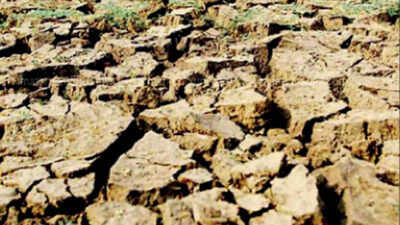Top Searches
- News
- City News
- kolkata News
- La Nina may cause heatwaves, damage crops in Bengal, northeast: Study
La Nina may cause heatwaves, damage crops in Bengal, northeast: Study

Representative image
KOLKATA: Meteorologists and climate scientists have predicted an increased probability of heatwaves this summer and pointed at a threat of crop damage in eastern India, including Bengal, and the northeast.
According to a report, compiled by Climate Trends, the prevailing weather conditions are a result of increasing global warming. Continuous rise in the global mean temperatures has been impacting the dynamics of larger weather phenomena, such as Western Disturbances and ENSO (El Nino Southern Oscillation). Change in the characteristics of the systems has affected precipitation in India in winter.
"There is fear of massive crop loss because of La Nina marked by colder-than-normal sea surface temperature in the equatorial Pacific Ocean that tend to suppress global temperature. But global warming and changing conditions tend to play a major role, which can be temporarily governed by these ENSO conditions but cannot completely outplay the effects of climate change. Natural climate events, like El Nino /La Nina /IOD, take place under the shadow of the more powerful, human-induced climate change," said G P Sharma, president, met and climate change, Skymet Weather.
Western disturbances, after causing precipitation over Western Himalayas, travel eastward towards the eastern part of the country. Simultaneously, if there is a system in the North Bay of Bengal, both systems interact with each other, bringing a good amount of rain over east and the Northeast. But, said meteorologists, we did not see much active western disturbances and even North Bay of Bengal witnessed less rain.
December 2022 was declared the warmest in 122 years, with the highest mean temperature. January, however, had a good spell of snow and rainfall in the western Himalayas, but there was no rain in the east or the Northeast. February was declared the hottest, recording the highest average maximum temperature since 1901. The east and the Northeast saw a rainfall shortage of 53% in December, 89% in January, and 34% in February.
"With global warming, western disturbances are getting lighter due to more convection and heat coming in. With this, they are tracking in the upper atmosphere. Of late, not all western disturbances lead to rain," said A P Dimri, director, Indian Institute of Geomagnetism. "The intensifying Arctic heatwave pulled up the weather systems, making them travel in higher latitudes and not having any effect on India's weather," said Mahesh Palawat, vice-president, meteorology and climate change, Skymet Weather.
According to a report, compiled by Climate Trends, the prevailing weather conditions are a result of increasing global warming. Continuous rise in the global mean temperatures has been impacting the dynamics of larger weather phenomena, such as Western Disturbances and ENSO (El Nino Southern Oscillation). Change in the characteristics of the systems has affected precipitation in India in winter.
"There is fear of massive crop loss because of La Nina marked by colder-than-normal sea surface temperature in the equatorial Pacific Ocean that tend to suppress global temperature. But global warming and changing conditions tend to play a major role, which can be temporarily governed by these ENSO conditions but cannot completely outplay the effects of climate change. Natural climate events, like El Nino /La Nina /IOD, take place under the shadow of the more powerful, human-induced climate change," said G P Sharma, president, met and climate change, Skymet Weather.
Western disturbances, after causing precipitation over Western Himalayas, travel eastward towards the eastern part of the country. Simultaneously, if there is a system in the North Bay of Bengal, both systems interact with each other, bringing a good amount of rain over east and the Northeast. But, said meteorologists, we did not see much active western disturbances and even North Bay of Bengal witnessed less rain.
December 2022 was declared the warmest in 122 years, with the highest mean temperature. January, however, had a good spell of snow and rainfall in the western Himalayas, but there was no rain in the east or the Northeast. February was declared the hottest, recording the highest average maximum temperature since 1901. The east and the Northeast saw a rainfall shortage of 53% in December, 89% in January, and 34% in February.
"With global warming, western disturbances are getting lighter due to more convection and heat coming in. With this, they are tracking in the upper atmosphere. Of late, not all western disturbances lead to rain," said A P Dimri, director, Indian Institute of Geomagnetism. "The intensifying Arctic heatwave pulled up the weather systems, making them travel in higher latitudes and not having any effect on India's weather," said Mahesh Palawat, vice-president, meteorology and climate change, Skymet Weather.
Start a Conversation
FOLLOW US ON SOCIAL MEDIA
FacebookTwitterInstagramKOO APPYOUTUBE









